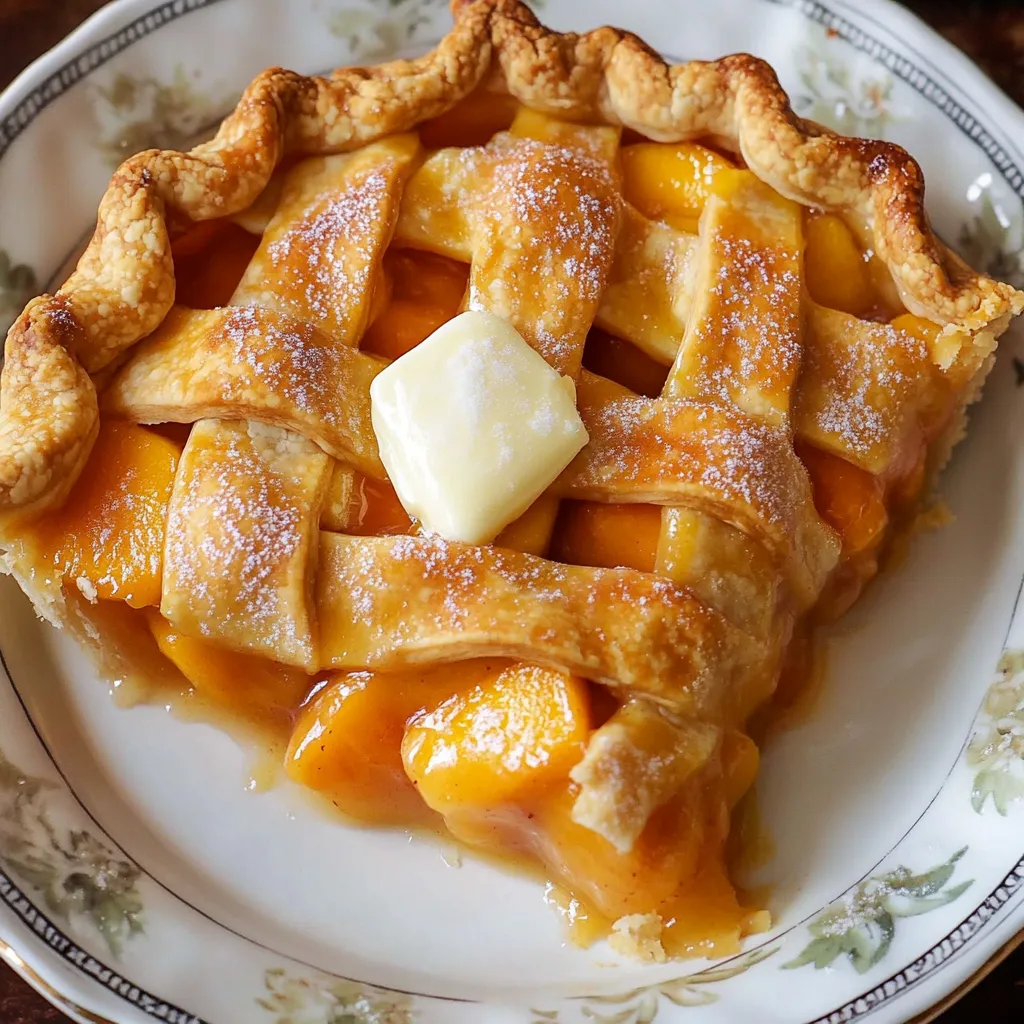 Pin it
Pin it
This stunning peach pie showcases summer's finest fruit wrapped in flaky, buttery pastry with an elegant lattice top. Fresh, ripe peaches get gently spiced with cinnamon and vanilla, then thickened with cornstarch to create a filling that's perfectly set but not gluey. The combination of sweet, juicy peaches and crisp, golden crust makes this the ultimate summer dessert that's guaranteed to impress at any gathering.
I'll never forget the first time I made this pie for a summer barbecue - the aroma of baking peaches and cinnamon filled the entire house, and when I pulled it from the oven with that golden lattice top, I felt like a real pastry chef. The hardest part was waiting for it to cool completely before cutting, but that patience paid off when the first slice came out clean with perfectly set filling. Now it's become my signature summer dessert, and I love how it uses up those gorgeous farmers market peaches that are too good not to showcase.
Essential Ingredients and Selection Tips
- Perfectly ripe peaches: They should smell intensely peachy and give slightly near the stem when pressed; avoid hard or overly soft fruit
- Quality pie crust: Homemade gives the best flavor and texture, but high-quality frozen works in a pinch; avoid cheap store brands
- Fresh lemon juice: Essential for brightening the flavors and preventing browning; bottled juice lacks the necessary acidity
- Cornstarch for thickening: Don't substitute with flour which creates a pasty texture; tapioca starch works as an alternative
- Cold butter: Must be ice-cold when dotted on the filling to create pockets of richness without melting into the fruit
- Coarse decorating sugar: Creates beautiful sparkle and slight crunch on the crust; regular granulated sugar works but isn't as pretty
Detailed Step-by-Step Instructions
- Prepare the peaches properly:
- Bring a large pot of water to boil and prepare an ice bath. Score an X on the bottom of 8-10 medium peaches, then blanch them in boiling water for 30-60 seconds until the skins start to loosen. Immediately transfer to the ice bath to stop cooking. The skins should slip off easily. Halve, pit, and slice the peaches into 1/2-inch thick wedges, working quickly to prevent browning.
- Create the perfect filling mixture:
- In a large bowl, gently combine the sliced peaches with 3/4 cup granulated sugar, 1/4 cup cornstarch, 2 tablespoons fresh lemon juice, 1 teaspoon vanilla extract, and 1 teaspoon ground cinnamon. Toss everything together until the peaches are evenly coated and the cornstarch is completely dissolved. Let this mixture sit for 15 minutes to allow the peaches to release their juices and the cornstarch to begin working.
- Roll and prepare the bottom crust:
- On a lightly floured surface, roll one disk of chilled pie dough into a 13-inch circle, turning it frequently and adding flour as needed to prevent sticking. Carefully transfer to a 9-inch deep-dish pie pan, gently pressing it into the corners without stretching. Trim the overhang to 1 inch all around. Place in the refrigerator while you prepare the lattice top.
- Create the lattice strips:
- Roll the second disk of dough into an 11-inch circle and use a pastry wheel or sharp knife to cut it into 1-inch wide strips. You should have 10-12 strips total. Place these on a parchment-lined baking sheet and refrigerate for 15 minutes to firm up, which makes them easier to handle during weaving.
- Fill and dot with butter:
- Remove the bottom crust from the refrigerator and pour in the peach mixture along with all the accumulated juices - this liquid contains dissolved cornstarch that's essential for thickening. Spread the peaches evenly and dot the surface with 3 tablespoons cold butter cut into small cubes. This adds richness and helps create a glossy filling.
- Weave the perfect lattice:
- Remove the strips from the refrigerator and lay half of them parallel across the pie, spacing them evenly. Fold back every other strip, place one strip perpendicular to the others, then unfold the folded strips over it. Continue this pattern, folding back alternate strips each time and placing the remaining perpendicular strips to create a beautiful woven pattern.
- Finish the edges professionally:
- Trim both the lattice strips and bottom crust overhang to 1 inch from the edge of the pie pan. Fold this excess dough under itself all around the pie, creating a thick border that sits on the rim of the pan. Use your fingers or a fork to crimp the edges, creating both a seal and decorative border.
- Apply egg wash and bake perfectly:
- Preheat your oven to 425°F with a baking sheet on the bottom rack. Beat 1 egg with 1 tablespoon water and brush this egg wash over the entire lattice and edges. Sprinkle with 1 tablespoon coarse sugar for sparkle. Cover the edges loosely with foil strips to prevent over-browning. Bake on the preheated baking sheet for 20 minutes, then reduce temperature to 375°F and continue baking for 40-50 minutes until the crust is golden and filling bubbles vigorously throughout.
- Cool completely for perfect slicing:
- Remove the pie from the oven and place on a wire cooling rack. This is the hardest part - you must let it cool for at least 4-5 hours before cutting to allow the filling to set properly. The pie is actually best served at room temperature, where the flavors are most pronounced and the texture is ideal.
 Pin it
Pin it
The first time I attempted a lattice top, I was intimidated by all the weaving, but it's actually much simpler than it looks. The key is keeping the dough strips cold so they don't tear, and not overthinking the pattern - even slightly imperfect lattice looks rustic and charming. My mother-in-law, who's an excellent baker, was impressed by the presentation and couldn't believe it was my first attempt. Now I actually prefer lattice tops because they're so much prettier than solid crusts.
Understanding Peach Selection and Ripeness
The success of peach pie depends entirely on using fruit at peak ripeness. Perfectly ripe peaches have a deep, fragrant aroma and yield slightly to gentle pressure near the stem. Underripe peaches won't develop enough natural sweetness or juice, while overripe ones become mushy and lack structure. The ideal peach should feel heavy for its size and have vibrant color without green undertones.
Thickening Chemistry and Cornstarch Function
Cornstarch works by absorbing liquid and swelling when heated, creating a gel-like consistency that holds the fruit together without masking flavors. Unlike flour, which can create a pasty texture, cornstarch produces a clear, glossy thickening that lets the fruit flavors shine. The cornstarch must be thoroughly dissolved in the fruit juices before baking to prevent lumps.
Crust Science and Temperature Control
The two-stage baking process serves specific purposes: high initial heat quickly sets the crust structure and begins browning, while the lower finishing temperature allows the filling to cook through without burning the pastry. The preheated baking sheet provides bottom heat that helps crisp the lower crust and prevents sogginess.
Lattice Technique and Visual Impact
A well-executed lattice top isn't just decorative - it allows steam to escape while creating an attractive presentation that showcases the fruit beneath. The weaving pattern should be even but doesn't need to be perfect; slight irregularities add handmade charm. Keeping the strips cold prevents tearing and makes handling much easier.
Cooling Process and Filling Structure
The extended cooling time allows the cornstarch to fully activate and the filling to set into its final consistency. During cooling, the fruit continues to release juices that get absorbed by the thickening agent, creating that perfect balance between set and tender. Rushing this process results in a pie that falls apart when sliced.
This pie represents everything I love about seasonal baking - taking advantage of ingredients at their absolute peak and transforming them into something that celebrates their natural beauty. The combination of technique and timing required makes it feel like a real accomplishment, and the results are so spectacular that it's become my go-to contribution for special occasions and summer gatherings.
Frequently Asked Questions
- → Do I need to peel the peaches for this pie?
- Peeling is optional. The skin softens during baking and adds color, but some people prefer the smoother texture without skin.
- → Can I use frozen peaches instead of fresh?
- Yes, but thaw and drain them first. You might need to add a bit more cornstarch since frozen peaches release more liquid.
- → How do I know when the pie is fully baked?
- The crust should be golden brown and the filling should bubble actively all over, including in the center of the pie.
- → Why does my pie need to cool for so long?
- The filling needs time to set and thicken properly. Cutting too early will result in a runny pie that won't hold its shape.
- → Can I make this pie ahead of time?
- Yes, the pie tastes great the next day. Store covered at room temperature for up to 2 days or refrigerate for longer storage.
- → What's the best way to prevent a soggy bottom crust?
- Bake the pie on a preheated baking sheet and make sure your oven is fully heated before putting the pie in.
